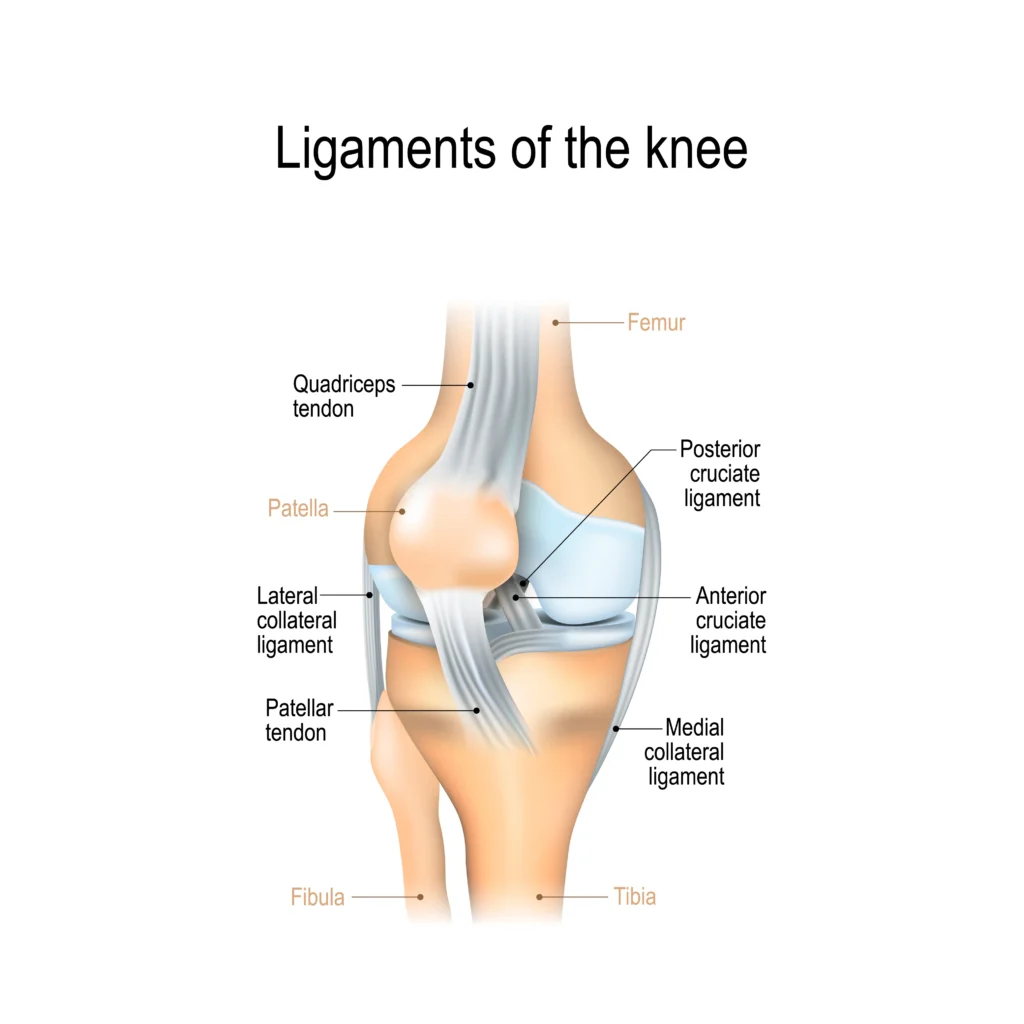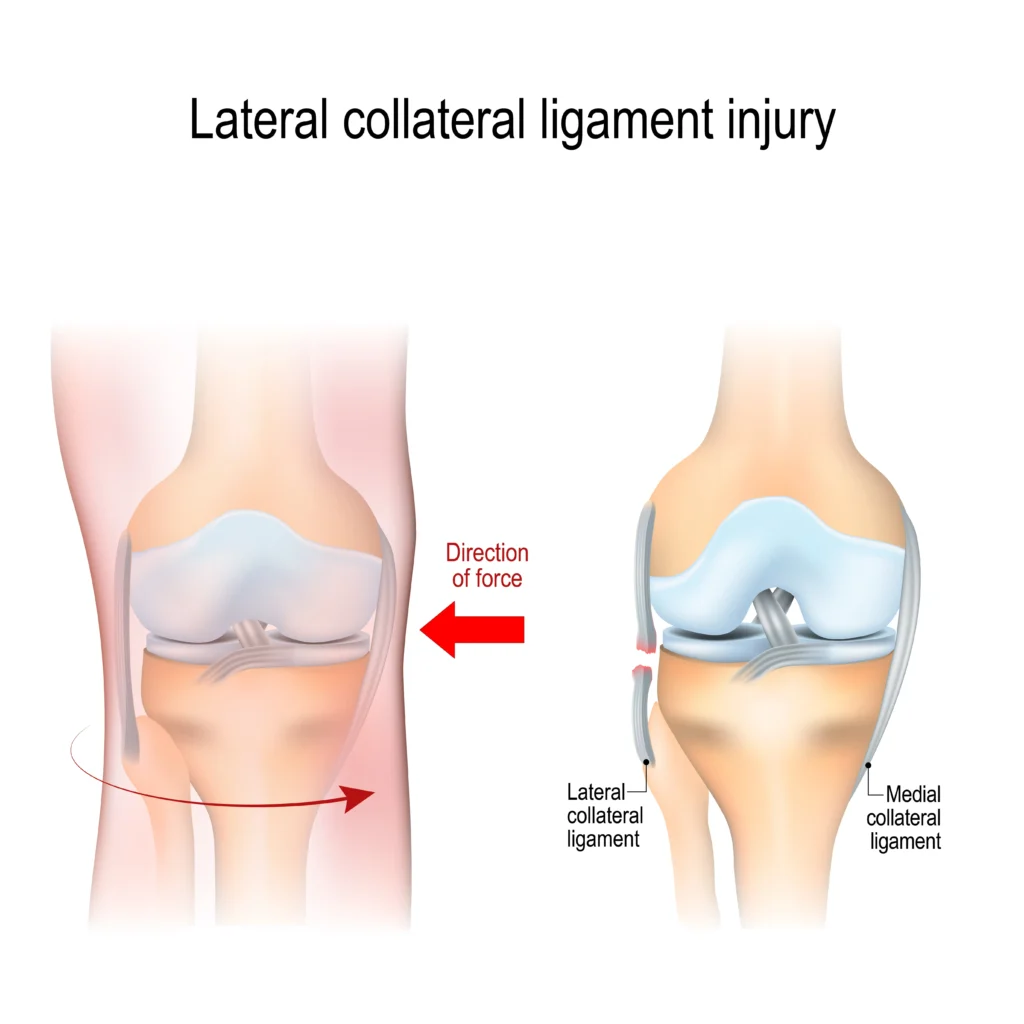Understanding Lateral Collateral Ligament (LCL) Sprain

Medically Reviewed By:
The lateral collateral ligament (LCL) is a crucial structure on the outer side of the knee that provides stability and prevents excessive side-to-side movement. An LCL sprain occurs when the ligament is stretched beyond its capacity. This injury can cause pain, swelling, and instability, affecting daily activities such as walking and climbing stairs.
Common treatments include pain medications and, in severe cases, surgery. However, the LCL has a good supply of blood. This makes the ligament capable of healing on its own, as the blood delivers essential nutrients and oxygen necessary for tissue repair.
Procedures using Regenexx lab processes support the body’s natural repair processes, offering an alternative to traditional treatments like medication and surgery.
What Is The LCL?
The LCL is one of the four major ligaments stabilizing the knee joint. It is located on the outer side of the knee and connects the femur (thigh bone) to the fibula (the smaller bone of the lower leg). The LCL plays a vital role in maintaining knee stability by preventing the knee from bending outward, which could lead to instability and injury.

The LCL is particularly important for lateral movements, such as running, cutting, or pivoting. It ensures that the knee joint remains aligned and functions properly.
An LCL sprain involves overstretching of the ligament fibers without a tear or rupture. It can cause pain, swelling, and mild instability in the knee. LCL tears may result from similar knee injuries, but they often involve the partial or complete rupture of the LCL fibers. They can cause more severe pain, swelling, and significant instability.
What Causes The LCL To Sprain?
The LCL can sprain when it is subjected to excessive stress or force, which stretches the ligament beyond its capacity. This typically occurs from activities that involve sudden movements, forceful twists, or direct impact on the knee.

Common scenarios include:
- Landing Awkwardly From A Jump: When landing from a jump, improper alignment or balance can cause the knee to bend outward, overstretching the LCL. The sudden force can strain the ligament, leading to a sprain. This type of injury is often seen in sports like basketball or volleyball.
- Direct Blow To The Outer Knee: A direct hit to the outer side of the knee can push the knee inward. This forces the LCL to stretch beyond its capacity and in an abnormal direction. This type of trauma is a common cause of LCL sprains and can vary in severity depending on the force of the impact. It is often seen in contact sports like football, soccer, or car accidents.
- Sports Cut: Sharp changes in direction, or cutting movements, are frequent in sports like soccer, tennis, or skiing. These sudden and forceful lateral movements can cause the knee to twist. This places significant strain on the LCL, increasing the risk of sprains.
What Are LCL Sprain Symptoms?
Symptoms of an LCL sprain can vary depending on the severity of the injury, which can be categorized into grades:
Mild Sprain
A mild sprain is categorized as grade 1. This type of injury typically results from a minor twist or impact that can place stress on the ligament. It can overstretch the fibers without tearing them.
Symptoms include:
- Pain: Overstretching of the ligament can cause inflammation, which results in mild pain, usually felt on the outer side of the knee.
- Mild Tenderness: The affected area may feel tender to the touch as the overstretched fibers and surrounding tissues become inflamed and sensitive.
- Minimal Swelling: Swelling occurs due to the build-up of fluids around the site of injury, which results from the body’s inflammatory response.
Moderate Sprain
A moderate LCL sprain is a partial tear, categorized as grade 2. It typically occurs due to a more significant force or impact, such as a sharp twist or direct blow to the knee. Grade 2 tears cause some damage to the ligament fibers, resulting in symptoms such as:
- Moderate Pain: Grade 2 injuries can cause more severe pain, usually localized on the outer side of the knee.
- Noticeable Swelling: The body’s inflammatory response to the tear causes noticeable swelling around the knee. This swelling is more prominent as the injury involves more extensive damage to the ligament.
- Difficulty Bearing Weight: The partial tear compromises knee stability, making it difficult to bear weight. The instability and pain make activities like walking or standing challenging.
Severe Sprain
A severe LCL sprain may be categorized as grade 3. It involves a complete tear, or rupture, of the LCL. This may result from a considerable force and severely affect knee function and stability.
Symptoms include:
- Significant Swelling: The complete tear triggers a significant inflammatory response, leading to considerable swelling.
- Knee Instability: With the ligament completely torn, the knee loses one of the primary stabilizing structures. This results in severe instability, making it difficult or impossible to bear weight or perform everyday activities.
Diagnosis And Examination
Diagnosing an LCL sprain usually involves several tests. It’s essential to note that popliteus pain, IT band pain or tears at the knee, and biceps femoris insertional tendon pain or tears are potential misdiagnoses due to their similar presentation to LCL injuries.
- Medical History Evaluation: The physician reviews the patient’s medical history and asks about the injury’s circumstances. This also helps exclude other conditions. Symptoms like pain and instability are noted to narrow down potential injuries.
- Physical Examination: During this phase, the physician performs specific tests to assess the knee. These include the Varus Stress Test, which involves applying pressure to the inner side of the knee. It helps detect LCL damage by revealing pain or looseness in the ligament.
Physicians in the licensed Regenexx network also use the industry-leading SANS evaluation. This involves analyzing the body in motion, reviewing existing imaging tests (MRI and/or X-ray), and, sometimes, using ultrasound to get a more accurate picture of what contributes to symptoms, how the function has been affected, and, ultimately, the root cause of pain.
- Imaging Tests: If necessary, imaging tests provide a clearer picture of the inside of the knee. X-rays examine hard tissues and help rule out bone fractures. MRI scans allow the physician to view soft tissues to determine the extent of the tear and other issues with ligaments, tendons, or cartilage.
Conventional Treatment Options
Conventional treatments for LCL sprains are commonly used to manage symptoms and promote healing.
- RICE Method: The RICE method includes rest, ice, compression, and elevation. Rest prevents further injury, while ice reduces inflammation and numbs pain. Compression helps control swelling, and elevation reduces fluid accumulation in the knee.
This method is a common first line of treatment for mild injuries, but a 2021 study highlighted that cold therapy may slow down healing by reducing the supply of blood and healing agents to the injured area.
- Bracing: Knee braces can stabilize the knee and limit movement, preventing additional damage to the LCL. Braces may provide external support but can also cause dependency, potentially delaying muscle recovery and preventing the knee from regaining strength.
- Physical Therapy: The goals of physical therapy for LCL sprains are to regain strength and improve stability. Exercises focus on strengthening the muscles supporting the knee and enhancing balance. The primary risks associated with physical therapy are over-exertion and further injury when exercises are not performed correctly.
Interventional Orthobiologic Approaches For LCL Injuries
Physicians in the licensed Regenexx network offer interventional orthobiologic procedures designed to support joint function and mobility.
Customized treatment plans may incorporate one or more Regenexx lab-processed orthobiologic injectates, including:
- Regenexx-SD injectate: Procedures using Regenexx-SD injectate include a proprietary protocol utilizing bone marrow concentrate (BMC), processed using Regenexx lab techniques.
- Regenexx-SCP injectate: A highly concentrated form of platelet-rich plasma (PRP) that isolates and concentrates growth factors from a patient’s blood. These concentrated growth factors are then injected using imaging guidance for precision.
- Regenexx-PL injectate: Regenexx-PL injectate is a specialized derivative of PRP designed for a rapid and targeted release of growth factors. It may be combined with other Regenexx orthobiologic injectates based on a patient’s condition.
Consult with a physician in the licensed Regenexx network to discuss your condition and explore whether this approach aligns with your needs.

Medically Reviewed By:
